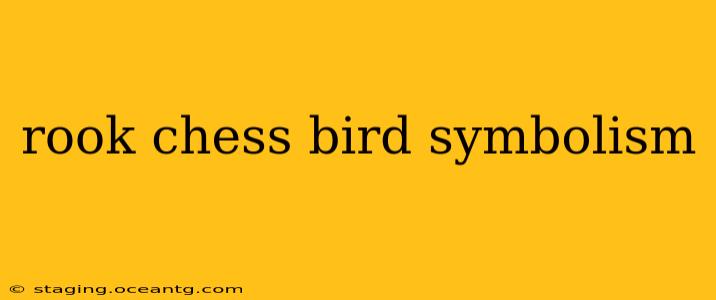The rook, a formidable piece in the game of chess, often evokes a sense of power and unwavering strength. While not explicitly depicted as a bird, its visual representation and strategic role lend themselves to interesting interpretations concerning avian symbolism. This exploration delves into the rook's symbolic connections to birds, examining its strategic importance within the game, and exploring the potential metaphorical links between the two.
What Bird Does the Rook Resemble?
This is perhaps the most intriguing question surrounding the rook's bird symbolism. There isn't a single definitive answer; the connection is more metaphorical than literal. However, several bird species share characteristics that resonate with the rook's attributes:
-
Raptors: The rook's imposing stature and ability to control vast areas of the board could be likened to the powerful flight and predatory prowess of raptors like eagles or hawks. They command the skies, much like the rook commands the ranks and files on the chessboard.
-
Large, soaring birds: Birds like storks or herons, known for their long necks and powerful wingspans, could also be considered metaphorical representations. Their majestic presence and commanding view from above parallel the rook's strategic overview of the chessboard.
Ultimately, the "bird" the rook resembles depends on the interpretation and the characteristics being emphasized. The strength, dominance, and far-reaching impact are key similarities across various avian species.
How Does the Rook's Movement Reflect Bird Behavior?
The rook's movement, restricted to horizontal and vertical lines, offers a unique perspective on avian behavior:
-
Direct and Unwavering Flight: The rook's straight-line movement mirrors the direct and often unwavering flight paths of many birds, particularly during hunting or migration. Their determination reflects the rook's steadfast pursuit of its objectives on the chessboard.
-
Territorial Control: The rook's control over entire ranks and files can be seen as analogous to a bird's territorial behavior. Just as a bird defends its territory, the rook guards its lines, preventing the opponent's pieces from advancing.
What is the Strategic Importance of the Rook in Chess?
The rook is one of the most powerful pieces in chess. Its long-range movement allows it to control vast swathes of the board and participate in both offensive and defensive maneuvers. Its importance is undeniable:
-
Key to Endgames: In endgames, the rook often becomes the dominant piece, capable of delivering checkmate on its own or in combination with other pieces.
-
Supporting Attacks: In the middlegame, the rook’s ability to control open files and support attacks makes it crucial in many tactical combinations.
-
Defensive Powerhouse: Rooks are also excellent defensive pieces, protecting vital squares and preventing enemy advances.
Is the Rook's Symbolism Important to the Game?
While the bird symbolism isn't explicitly part of the rules or traditional interpretations of chess, understanding these metaphorical connections can enrich one's appreciation of the game. It adds another layer of depth, transforming the pieces from mere game elements into symbolic representations of power, strategy, and control. Seeing the rook as a powerful bird helps to visualize its strategic capabilities and understand its crucial role in the game.
Why is the Rook So Powerful in Chess?
The rook’s power stems from its long-range mobility and its ability to control entire files and ranks. This gives it a significant advantage in both attack and defense. Its long reach allows it to threaten multiple pieces simultaneously, forcing the opponent to react defensively and limiting their options.
What are the Different Strategic Roles of a Rook?
The rook's strategic roles are versatile and dependent on the game situation:
-
Offensive Rook: Often positioned on open files to support attacks against the opponent's king or other key pieces.
-
Defensive Rook: Used to protect the king, control important squares, and prevent enemy incursions.
-
Combined Attack: Working in conjunction with other pieces, particularly queens and bishops, to launch powerful attacks.
Understanding these nuanced roles is crucial to mastering the game of chess.
By exploring the subtle connection between the rook and avian symbolism, we gain a deeper appreciation for its strategic value and overall power within the game of chess. The rook, powerful and commanding, stands as a testament to the intricate blend of strategy, symbolism, and artistry inherent in this ancient game.
